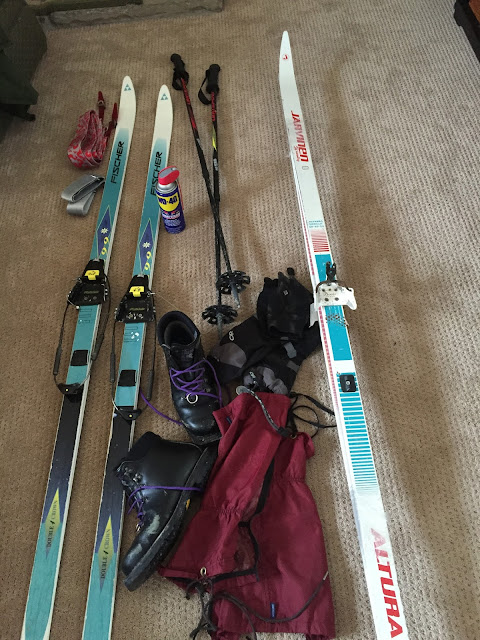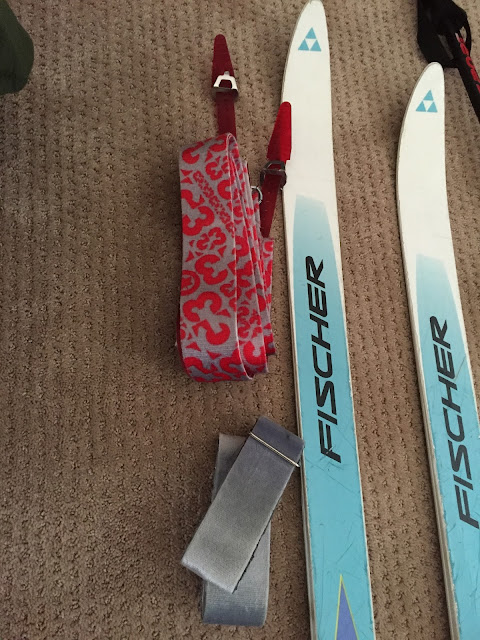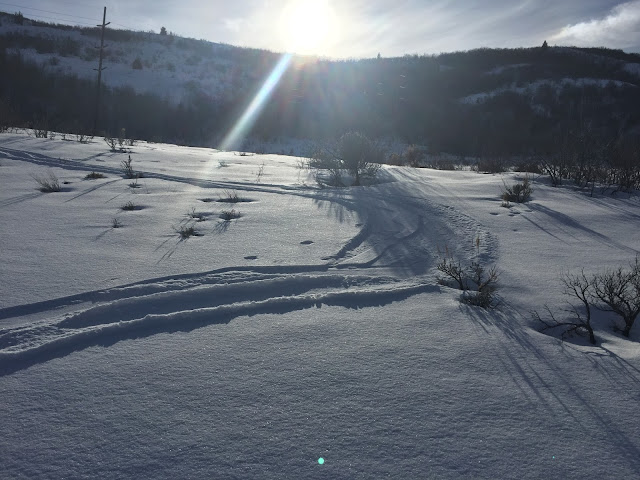Since I retired and we moved to Park City, skiing has once again become a big part of my life, especially since this year there has been a lot of snow in Utah. Since the beginning of the skiing season, I've probably skied more days than I haven't, and just like in Flagstaff, here it's not really a "project" to go - you can just take off into the hills behind the house.
One problem, however, is the confusion over what I mean when I say I "went skiing." It is not what people think about, especially here in Park City in the midst of world class ski resorts. The off trail, cross country type of skiing I enjoy so much is really a very small, and likely shrinking, "niche" around here at least. That's the topic of this blog entry.
It all started in Estes Park in Colorado up near Rocky Mountain National Park where the pictures of Andy and Alisa above were taken many years ago. There is a reason why Alisa and Andy on skis are not in the same picture. To economize and because I wasn't sure whether they would like cross country skiing, rather than just sledding, I only rented once set of skis, boots and poles for them and made them share - take turns. Although many years ago and well intentioned, I've never been forgiven for doing that (and, really, it was unforgivable - xc equipment is really pretty cheap to rent). However, the incident is telling in that "cheap" seems to be a reoccurring theme in my skiing.
The pictures are also instructive in two other ways. First, it is not downhill/alpine skiing (which is what most people think of, especially here in Park City, when you mention skiing). This is cross country/nordic skiing with a free heel, a style designed to travel across the snow without or without a trail. As you go your heel is "free" to rise or lift just it does when you walk. In contrast, in downhill/alpine skiing the heel is fixed by bindings tightly to the ski (it can't come up). This provides better control of the skis going downhill and making turns, but makes it difficult to travel uphill or horizontally. I and everyone else in the family downhill ski and we've gone downhill skiing in some pretty nice places, but this blog posting is about the backcountry nordic or cross country skiing I like to do.
Second, while Andy and Alisa are clearly cross country skiing in the pictures, they are not on a groomed trail. Around here, when folks talk about cross country skiing they are now usually thinking of skiing on groomed trails with two parallel tracks on the sides for "classic" skiers between a wide groomed area for "free style" or "skating" skiers. As depicted in the pictures of Andy and Alisa, we just found a nice place off the road in the national forest and took off across the country. This is the other distinguishing feature of this style of cross country skiing - no need for a groomed trail or resort - just open country.
Family History - Andy's Essay
Nordic Hyers
The link is to a PDF file on Google drive. I haven't figured out yet how to actually paste a PDF file into this blog. You should read this story again. Andy gives a nice sense of our family's cross country skiing adventures in the places we've lived, along with some interesting western history. The picture below is Andy somewhere up near Carson Pass in the Sierras. That area is, among others, described in the essay.

Equipment
Frankly, as a skier I'm something of an anachronism - skiing in 2016 on equipment from the 1980s I bought used in the 1990s, but it still seems to work. Here's my gear:
Skis
Let's start with the skis. The skis on the right are the ones I bought in Flagstaff at the time we bought a bunch of skis for the family. The ones on the left, the Fischer E99 Double Crown skis, are what I generally use now. For better control in backcountry conditions, the Fischer E99s have metal edges and are little wider than regular XC ski. They would be considered backcountry touring skis. I bought the E99s skies as used rentals from a shop in Danville. They've turned out to be great skis for me.
However, you rarely see these skis now in the West, especially in Park City, since folks now are usually looking for skis that turn easily going downhill in deep powder - wide skis with little "camber" (the bow in the ski). (In Park City, the "vertical" aspect of skiing rules over the "horizontal".) However, with the wide ski and little camber you lose the benefit of the "glide" normally associated with XC skiing. When used with climbing skins you can walk up the mountain on wide skis and, after removing the skins, ski down with bowls with nice turns just like with the now popular wide downhill skis. However, in flat or less steep terrain they don't work all that well, as you have no real glide with those skis. For me a big part of what makes xc skiing fun and efficient is the glide. (If anyone is interested I can explain why this camber, glide, waxless/wax xc ski works.)
With these skis I can go most anywhere in the backcountry - think of going hiking in the winter but with a nice a glide, especially downhill. When I went snow camping (snow caves) with the Scouts (Andy, Dave and Daniel) in California, I was a bit of an oddity skiing in on these skis rather than snowshoes like everyone else. But the skiing was more fun. In my view, snowshoes are for those rare places where it is too steep or wooded to navigate with skis or for those who don't know how to ski.
Bindings
When I bought those skis back in Danville it was really for the bindings (not the skis) and what I really liked about those bindings was that they were not this:
I think everyone in our family grew to hate the three-pin bindings, although they were at that time standard for cross country skis. There were always problems being sure you got the pins set properly in the boot and sometimes you would think you did and you hadn't and the boot would slip out and then the pins would mess up the corresponding holes in the front of your boot. I really grew to really dislike that binding.
While we lived in Danville, Andy and I went cross country skiing in the Sierras and I rented some skis from a ski shop in Danville. The rentals had this Rottefella cable binding (interesting side note: "Rottefella" is Norwegian for rat trap), instead of the 3-pin binding. These cable bindings were a common setup back then for backcountry/telemark skiing. I liked the bindings (or really the absence of the three pins). When we returned the skis, the shop was selling some used rentals and I bought them (skis with the bindings) for $100. It was a very, very good deal. Ironically, nowadays hardly anyone uses a cable binding. There is now the "new nordic norm backcountry" binding and a whole new world of "alpine touring" setups, although the three pin binding is still around and is probably still the preferred "nordic" binding for backcountry skiing.
Boots
 Now the boots. At that time the industry had gone almost entirely to boots made from synthetic materials (largely plastic) for backcountry skiing as well as every other kind of skiing and has never looked back. Those boots are stiffer and provide better control than the old leather boots. That's what I got when we rented the backcountry skis that time in California. Although I don't mind the big, plastic, stiff boots for downhill skiing (and they really work well), I hated them on this cross country ski trip. They made my feet ache and were awkward to walk in. I wanted something a bit more comfortable (even at the sacrifice of skiing performance) and something you could walk around in like a normal person when you didn't have the skis on (say, for example, when you went snow camping with the scouts). I wanted the old fashioned leather boots.
Now the boots. At that time the industry had gone almost entirely to boots made from synthetic materials (largely plastic) for backcountry skiing as well as every other kind of skiing and has never looked back. Those boots are stiffer and provide better control than the old leather boots. That's what I got when we rented the backcountry skis that time in California. Although I don't mind the big, plastic, stiff boots for downhill skiing (and they really work well), I hated them on this cross country ski trip. They made my feet ache and were awkward to walk in. I wanted something a bit more comfortable (even at the sacrifice of skiing performance) and something you could walk around in like a normal person when you didn't have the skis on (say, for example, when you went snow camping with the scouts). I wanted the old fashioned leather boots.They were hard to find, but I finally found a pair at the REI store in Walnut Creek. Sitting alone at the far end of a rack with about 15 different styles of synthetic material boots was a single pair of rather forlornly looking leather boots. I bought them. They're great, although I think I'm likely the only person Park City (and probably the western world) still skiing in leather boots (with possible exception of Andy, who got a great deal on some used leather XC/telemark boots in Boise a few years ago and uses them). I suspect now I could find some very comfortable, lighter weight, non leather boots that would likely work better. But getting boots that fit and are comfortable and that are also easy to walk in off the skis can by tricky. Mine still seem to work fine for what I do.
WD40

One early Spring day when we lived in Flagstaff Andy and I went skiing north of town at a little higher in elevation, since the snow near our house was largely gone. It was warm, wet, sticky snow. The trip was a disaster. The snow stuck in huge globs to the bottoms of our skis. It was like trying to ski with a brick on the bottom of the skis that kept getting bigger as you went along. A guy along the trail pointed out that we needed to put some WD40 on the bottom of the skis. We tried it. It works.
Actually, snow accumulating on the bottom of your skis when the snow is "wet" and the temperature is around freezing (30+ degrees) is a common problem - a real "bane" for XC skiers. If you go into in XC ski shop you'll find a confusing number of different color coded waxes to deal with this and any number of other snow conditions. While WD40 seems to be too much of a "red neck" kind of solution for a sport dominated by sophisticated Europeans and Easterners, it works and is a whole lot simpler (and cheaper) than trying to figure out all those waxing schemes.
The climbing skins are new this year and I should have got some years ago. A problem with my style of skiing in Park City is that I'm usually skiing up trails on mountains (typically what would be mountain biking or hiking trails in the summer), not flat terrain or rolling hills. Going up on skis is obviously a problem, since the skis want to slide back downhill. Usually, with herringbone (duck) steps, side steps and careful use of poles I can get up the steep parts of any trail, although it can be something of a scramble. However, the descent can be the greater problem. The trails are usually narrow, often winding through trees, and don't allow for sweeping turns to reduce rate of descent or check the speed. It can be more like skiing down a narrow bobsled run - before you know it you're going way to fast, lose control and crash. Once the trails become packed down or icy, which happens here because hikers in boots or on snowshoes use the same trails, the ascent and descent problems become serious obstacles.
Climbing skins are made of a fabric with tiny fibers pointing rearward to prevent you from sliding backward while allowing you to glide forward. Picture a dog's fur that can be stroked smoothly one way, but stands up when you run your hand the other way. The skins attach to the bottom of the ski by an adhesive and a clip and the top and sometimes another clip at the end of the ski. The adhesive will hold the skin to the ski, but you can then pull the skin off thte ski (without leaving any adhesive on the ski but with the adhesive remaining on the skin) and reuse the skins multiple times.
This winter I bought some "nordic skins" online from a guy in Sun Valley, Idaho for $35. They extend from the tip of the ski to near the middle of the ski just where the "fish scales" section of the waxless ski begins (i.e., they don't extend the full length of the ski). They're the grey ones in the picture above. Andy bought some full length skins for his cross country skis, but then got some wide skins on eBay for his wider telemark skis. Since the narrow skins (red and white above) will fit my skinny skis, he gave them to me for my birthday.
The skins work great and have really changed the experience here. With the skins (especially the full length ones) I can essentially walk straight up the trails with without any slipping back. Also, if the trail is icy or the descent otherwise a problem, I can leave the skins on when going down. You can ski down fine with the skins, they don't really hold you back that much, but they do slow you down a bit on the descent helping you maintain control.
Poles
The poles in the picture above are Leki backcountry poles - a leading German ski pole manufacturer. They were given to me as a birthday present when we lived in California. Also, a year or so ago Evie bought me some Black Diamond hiking poles (so I would stop using hers). She got some bigger snow baskets for them this year. While I may have old junk skis and old fashion worn out leather boots, I have pretty cool poles (Leki or Black Diamond) even among the Park City backcountry crowd.
Trekking on skis - the glide
This is what I really like about skiing here. These pictures are on the mountains above our house. You're off the trail going over routes with for the most part a gentle incline, easy to ski up and when going down you're smoothly moving across the snow with nice long glides in the "classic" style - imagine rollerblading on a moving walkway (like what they have at airports). It's like going for a pleasant walk in the woods, but more fun.
The supremely elegant "telemark" turn
The picture above is no one we know. I just down loaded it from the web to illustrate the telemark turn.
A problem with cross country skiing is making turns. Since the heel is free (not attached to the ski) you don't have the same control over the skis as you do with a fixed heel as in alpine/downhill skiing, making it difficult to turn. You really can't do the normal "parallel turns" with a carving or "up down" motion used in downhill skiing.
Many years ago the Norwegians solved this problem with the "telemark" turn (named for Telemark, Norway, which incidentally is where our Hyer ancestors were originally from). In the telemark turn, the skier moves the downhill ski forward, puts most of the skier's weight on that downhill ski while turning it. The uphill ski, without much weight on it, will just follow the downhill ski around in the turn. The distinctive feature of the turn is the bent knee and raised heel on the following uphill ski. When done well, it is a very elegant turn.
With improvements in the "alpine touring" ski equipment, which allow the skier to walk up with a free heel, but then lock the heels down for the descent, telemark skiing probably isn't a popular as it once was and is now more of a "niche" sport. Nevertheless, it is a very elegant turn and even today any skier nicely connecting a series of telemark turns will have the respect of everyone on the mountain.
I took a lesson in telemark skiing for an hour or so once in California at Kirkwood. I sort of got the hang of it, but never could do it very well, and my narrow skis with high camber don't make it all that easy to do anyway. On a good day, however, I could probably make the turns in the picture above, albeit with a little less grace. Andy, especially with his wider telemark skis, certainly could.
This is a picture of my tracks of a telemark turn I made this afternoon. Unfortunately, I'm really not very good at it and with age, I'm not likely to get much better.

I have, however, long since reconciled myself to the fact that I will never telemark ski like the above skier or those in this youtube video of telemark skiing in Utah.
Telemark Skiing - Utah
And you just never know where this all may come in handy












No comments:
Post a Comment